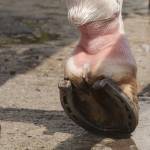Pastern Dermatitis in Horses: Causes and Care

Equine pastern dermatitis (EPD) is a problematic skin condition that can be caused and perpetuated by a variety of environmental and genetic factors.
Because there is no specific causative agent for EPD, such as an identifiable pathogen, avoidance is difficult. However, consistently wet and dirty skin on the lower legs makes a horse susceptible to EPD. Thus, draft horses are most vulnerable because heavy feathering on their lower legs retains moisture and debris. EPD is also more commonly seen on white areas of the leg, so horses with leg markings tend to be affected more frequently.
Presentation of EPD ranges from mild to severe. The mildest form is called scratches, and it is distinguished by inflamed skin and small scabs. The more serious form, known as grapes, is characterized by hard plaque-like formations of skin.
The causes of EPD are as numerous as the presentations of the syndrome. Certain horses are genetically predisposed, either through draft horse bloodlines or through auto-immune compromise. Horses kept in wet conditions are also more likely to develop symptoms, hence the common name dew poisoning. Parasites, caustic chemicals, and fungi are additional contributing factors.
A horse with EPD will display progressive symptoms, from scabbing in the caudal pastern region to unyielding skin plaques, which are most difficult to treat and can cause lameness. It is important to monitor the pastern regions of horses to catch EPD in its earliest stages. Scabs and inflamed skin are early indicators.
Once the warning signs are detected, it is helpful to shave the affected area to allow direct topical treatment and to keep the skin dry. Scabs can be removed by soaking the area in warm water or using antibacterial agents. It will likely be painful for the horse to have his or her scabs removed. Once the area is clean, treatment can begin.
EPD can be treated topically or systemically, as prescribed by a veterinarian. Common topical treatments include antibacterial and antifungal creams, and systemic treatments range from antibacterial and antifungal medicines to preparations formulated specifically for auto-immune diseases.
Dietary supplements can also be beneficial in treating EPD and in preventing its recurrence. EO•3, an omega-3 supplement produced by KERx, can alleviate or circumvent this syndrome through the regulation of inflammatory and allergic response mechanisms.
Once EPD has been eradicated, continue to monitor the affected area and keep the skin as dry as possible through regular grooming and stall maintenance.








